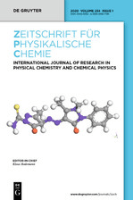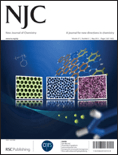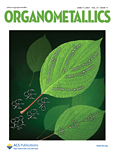
MAIN GROUP CHEMISTRY
Scope & Guideline
Connecting Researchers with Pioneering Chemical Discoveries
Introduction
Aims and Scopes
- Synthesis and Characterization of Main Group Compounds:
The journal emphasizes the development of new synthetic methods for main group compounds, exploring their structural and functional properties through various characterization techniques. - Applications in Environmental Chemistry:
Research often addresses the application of main group compounds in environmental contexts, such as photocatalysis, wastewater treatment, and sensor development. - Biological and Medicinal Chemistry:
The journal highlights studies on the biological activities of main group compounds, including their potential as antimicrobial agents and anticancer drugs. - Computational Chemistry and Theoretical Studies:
A significant portion of the research involves computational methods to predict properties and behaviors of main group compounds, aiding in the design of new materials and drugs. - Nanomaterials and Advanced Materials:
The journal covers advancements in the synthesis and application of nanomaterials derived from main group elements, focusing on their unique properties and potential uses in technology.
Trending and Emerging
- Photocatalysis and Environmental Remediation:
Recent studies emphasize the use of main group compounds in photocatalytic processes for environmental cleanup, showcasing the growing importance of sustainable chemistry. - In Silico Drug Design and Molecular Docking:
There is an emerging trend in using computational chemistry for drug design, particularly in the context of developing new therapeutic agents against diseases like COVID-19. - Green Chemistry and Sustainable Practices:
Research focusing on environmentally friendly synthesis methods and the application of main group compounds in green chemistry is on the rise, aligning with global sustainability goals. - Nanotechnology in Medicine and Catalysis:
The integration of nanotechnology with main group chemistry for applications in drug delivery systems and catalytic processes is increasingly highlighted in recent publications. - Smart Materials and Responsive Polymers:
There is a growing interest in the development of smart materials, including polymers that respond to environmental stimuli, leveraging the unique properties of main group elements.
Declining or Waning
- Traditional Organic Synthesis:
There has been a noticeable decrease in publications focused solely on traditional organic synthesis methods, as the field has shifted towards more innovative and environmentally friendly approaches. - Basic Coordination Chemistry:
Research centered on fundamental coordination chemistry of main group elements is becoming less prominent, as more emphasis is placed on applications and interdisciplinary studies. - Inorganic Reaction Mechanisms:
The exploration of basic inorganic reaction mechanisms has waned, with fewer studies focusing on the mechanistic aspects of reactions involving main group compounds. - Low-Dimensional Materials:
While still relevant, the specific focus on low-dimensional materials (e.g., 2D materials) derived from main group elements has decreased, possibly due to the rise of more advanced materials research.
Similar Journals

EUROPEAN JOURNAL OF INORGANIC CHEMISTRY
Navigating the Complexities of Inorganic ChemistryThe EUROPEAN JOURNAL OF INORGANIC CHEMISTRY, published by WILEY-V C H VERLAG GMBH, is a premier peer-reviewed journal dedicated to advancing the field of inorganic chemistry. With an ISSN of 1434-1948 and an E-ISSN of 1099-0682, this journal has established itself as a key platform for the dissemination of innovative research, reviews, and features since its inception. As of 2023, it holds a respectable Q2 quartile ranking in the domain of inorganic chemistry, reflecting its influence and contribution to the scientific community—ranking #33 out of 79 in Scopus’ assessment and placing the journal in the 58th percentile. The journal encompasses a wide range of topics within inorganic chemistry, making it a valuable resource for researchers, professionals, and students alike. Although the journal does not currently offer open access, it remains an essential outlet for high-quality, impactful studies in inorganic chemistry, showcasing significant advancements and fostering collaboration among scholars globally.

Heterocyclic Letters
Fostering Excellence in Heterocyclic Compound StudiesHeterocyclic Letters is an esteemed journal in the field of synthetic organic chemistry, published by RAMAN PUBL. With ISSN 2231-3087 and E-ISSN 2230-9632, this journal aims to disseminate original research and innovative findings related to heterocyclic compounds, which play a crucial role in medicinal chemistry, material science, and agricultural chemistry. Heterocyclic Letters provides a platform for researchers, professionals, and students to share their insights and advancements, thus fostering academic collaboration and knowledge transfer. The journal is dedicated to maintaining high-quality standards in research publication, making it an essential resource for anyone focused on the latest developments in heterocyclic chemistry. Although it does not currently offer Open Access options, the journal’s rigorous peer-review process ensures that only the most credible and impactful studies are published, contributing significantly to the advancement of the field.

DOKLADY CHEMISTRY
Connecting scholars through cutting-edge chemistry insights.DOKLADY CHEMISTRY is an esteemed academic journal published by MAIK NAUKA/INTERPERIODICA/SPRINGER, focusing on the dynamic field of chemistry. Established in 1996, this journal serves as a significant platform for disseminating cutting-edge research, reviews, and significant developments in various areas of chemistry, including but not limited to general and miscellaneous chemistry. Currently indexed with an ISSN of 0012-5008 and E-ISSN of 1608-3113, DOKLADY CHEMISTRY maintains a commitment to academic rigor and integrity, contributing critical insights to the scientific community. Despite its Q4 ranking in the 2023 Chemistry category and a Scopus rank of #314 out of 408, this journal remains an important resource for researchers, professionals, and students eager to explore emerging trends and innovative methodologies in the field. The journal operates under a model that supports comprehensive scholarly communication, making it a key fixture among established chemistry publications.

ZEITSCHRIFT FUR PHYSIKALISCHE CHEMIE-INTERNATIONAL JOURNAL OF RESEARCH IN PHYSICAL CHEMISTRY & CHEMICAL PHYSICS
Fostering Excellence in Chemical ResearchZEITSCHRIFT FUR PHYSIKALISCHE CHEMIE-INTERNATIONAL JOURNAL OF RESEARCH IN PHYSICAL CHEMISTRY & CHEMICAL PHYSICS, published by WALTER DE GRUYTER GMBH, is a highly regarded platform for researchers in the field of physical chemistry and chemical physics. With an ISSN of 0942-9352 and an E-ISSN of 2196-7156, this journal serves as a vital resource for the dissemination of original research, critical reviews, and insightful discussions that span theoretical and experimental investigations. Recognized for its quality, it holds a Q2 classification within the 2023 quartiles of Physical and Theoretical Chemistry and ranks 72nd out of 189 in the Scopus database, placing it in the 62nd percentile. The journal’s extensive publication history, originating from 1943, showcases its long-standing commitment to advancing the understanding of complex chemical phenomena. Although it currently does not offer open-access options, it continues to attract contributions from leading experts worldwide, making it essential reading for professionals, researchers, and students dedicated to pushing the frontiers of chemical science. The journal is located in Berlin, Germany, at Genthiner Strasse 13, D-10785 Berlin, Germany.

NEW JOURNAL OF CHEMISTRY
Elevating Knowledge in Chemistry and BeyondNEW JOURNAL OF CHEMISTRY, published by the prestigious Royal Society of Chemistry, serves as a vital platform for the dissemination of research in the dynamic fields of chemistry, catalysis, and materials science. With an impressive ISSN of 1144-0546, this journal boasts a rich history, having been established in 1996, and is set to continue its impactful publication through 2024. The journal is recognized in several categories, achieving a Q2 ranking in both chemistry and materials chemistry, and a Q3 rank in catalysis, reflecting its significance within these disciplines. Researchers will find it particularly noteworthy that the journal holds an esteemed position in the Scopus rankings, with a 65th percentile standing in general chemistry. Though it currently operates on a subscription model, its commitment to advancing the frontiers of chemistry makes it an essential resource for academics, professionals, and students seeking to keep abreast of the latest advancements and innovative methodologies in their fields.

JOURNAL OF STRUCTURAL CHEMISTRY
Exploring the Foundations of Structural ChemistryThe JOURNAL OF STRUCTURAL CHEMISTRY, published by PLEIADES PUBLISHING INC, is a premier resource in the fields of Inorganic Chemistry, Materials Chemistry, and Physical and Theoretical Chemistry. Established in 1960, this journal has been providing a platform for groundbreaking research, facilitating the advancement of knowledge and innovation up to the year 2024. With an ISSN of 0022-4766 and an E-ISSN of 1573-8779, this journal strives to maintain high academic standards, as evidenced by its quartile rankings in 2023, where it ranks Q4 across various chemistry categories. While it currently does not offer open access, the journal's insightful articles are crucial for professionals and students seeking to enhance their understanding and expertise in structural chemistry. Subscribers can expect a comprehensive collection of peer-reviewed research, empirical findings, and theoretical discussions that contribute significantly to the scientific community. With its strong historical foundation and ongoing commitment to quality, the JOURNAL OF STRUCTURAL CHEMISTRY continues to be an essential resource for those passionate about the complexities of structural chemistry.

Chemical Methodologies
Unlocking the Potential of Chemical MethodologiesWelcome to Chemical Methodologies, a premier journal published by SAMI PUBLISHING CO-SPC, dedicated to advancing the field of chemistry through innovative research and methodologies. With an ISSN of 2645-7776 and an E-ISSN of 2588-4344, this journal provides a vital platform for researchers and scholars to share their findings in areas encompassing physical, theoretical, and organic chemistry. Despite its initial HIndex and quartile rankings still being established, the journal's evolving impact within the academic landscape is underscored by its Scopus Ranks, which place it in the 35th percentile for physical and theoretical chemistry and the 33rd percentile for organic chemistry. Since its inception in 2022, and continuing through 2024, Chemical Methodologies aims to foster collaboration and knowledge dissemination among academics and practitioners alike, bridging theoretical concepts and practical applications. This open-access platform enhances accessibility for researchers and students worldwide, ensuring that groundbreaking contributions to chemical science reach a broad audience.

ORGANOMETALLICS
Exploring the Intersection of Metal and Organic ChemistryORGANOMETALLICS is a prestigious journal published by the American Chemical Society, specializing in the multidisciplinary field of organometallic chemistry. With an impressive history spanning from 1982 to 2024, this journal has established itself as a critical resource in the scientific community, holding a distinguished Q1 ranking in Inorganic Chemistry and Q2 rankings in both Organic Chemistry and Physical and Theoretical Chemistry for 2023. The journal's robust impact factor reflects its significance, ranking among the top-tier publications in its category; for instance, it ranks 27th out of 79 in Inorganic Chemistry. Researchers and professionals in the field eagerly contribute their findings, ensuring the journal remains at the forefront of contemporary chemical research. Although ORGANOMETALLICS does not currently offer open access options, it provides an essential forum for innovative research, discussions, and advancements in organometallic science. Its commitment to excellence makes it an invaluable resource for researchers, professionals, and students dedicated to exploring the rich interplay between metals and organic compounds.

JOURNAL OF THE INDIAN CHEMICAL SOCIETY
Connecting Research, Innovation, and Collaboration in ChemistryJournal of the Indian Chemical Society, published by Elsevier, stands as a cornerstone in the field of chemistry, particularly representing the rich chemical research emanating from India.
With a significant history dating back to its establishment, this journal encompasses diverse disciplines including Drug Discovery, Electrochemistry, Inorganic Chemistry, Organic Chemistry, and Physical and Theoretical Chemistry, reflecting the evolving landscape of chemical sciences.
Despite being positioned in the Q3 category across multiple quarters, the journal demonstrates promising rankings in various chemistries, highlighting its commitment to advancing the knowledge and application of chemical sciences. While currently not available as an open access journal, the Journal of the Indian Chemical Society is dedicated to providing a platform for high-quality research that fosters innovation and collaboration among researchers, professionals, and students worldwide.
With its continuous publication from 1973 to the present, it serves as an essential repository for cutting-edge findings and developments in chemistry, striving to connect academia with industry and practice.

ACTA CHIMICA SLOVENICA
Fostering Curiosity and Knowledge in ChemistryACTA CHIMICA SLOVENICA is a distinguished peer-reviewed journal dedicated to advancing the field of chemistry, published by the SLOVENSKO KEMIJSKO DRUSTVO. With an ISSN of 1318-0207 and E-ISSN 1580-3155, this journal has been an essential resource for researchers and professionals since its inception in 1996. Recognized for its commitment to open access since 1998, it fosters global collaboration by making research widely available. Based in Slovenia, the journal operates with a focus on various domains within chemistry, achieving a respectable Q3 ranking in 2023 within the miscellaneous chemistry category on Scopus, showcasing its impact and relevance. This journal serves as a vital platform for innovative research, reviews, and discoveries, aiming to enhance knowledge and ignite curiosity in a diverse readership, including students and emerging scholars in the field.